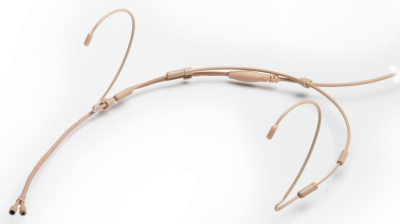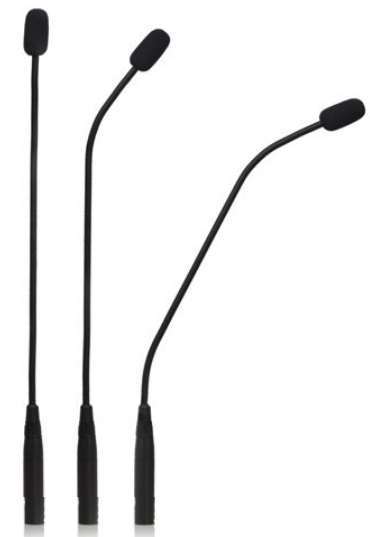
Podium
While we commonly call them “podium” mics, most of the time they’re mounted to a lectern. Many standard handheld mics on gooseneck stands can work well for this purpose but they don’t look nearly as nice as their purpose-built counterparts, particularly on camera. A far better option when possible are compact gooseneck condenser mics that are purpose-designed.
They’re usually dark in color and have a relatively small capsule/element positioned atop a long slender gooseneck that’s easy to adjust. Because the element is small and light, the gooseneck stays where it’s put and doesn’t fail over numerous uses.
Podium mics come in a variety of types and lengths as well as different mounting options. One way to categorize them is by their pickup patterns. Omnidirectional models are great for recording but don’t work nearly as well for most live PA applications, where more directional designs are the better choice. Cardioid models are most popular because the wider pickup pattern is more forgiving when there are a variety of different presenters over the course of an event.
This isn’t to say, however, that supercardioid and hypercardioid patterns aren’t worth considering. When properly positioned, they can work extremely well, with their tighter pattern helping to reject unwanted sounds and reduce feedback issues.
Other ways to categorize gooseneck podium mics is length. Shorter goosenecks work well on desks where a presenter or presenters will be sitting typically running from 3 inches to 12 inches in length. Models for podiums/lecterns typically are a bit longer, ranging from 12 inches to more than 20 inches. A popular length is 18 inches, which accommodates a wide range of adjustment.
There are also a variety mounting options. Models with a built-in base can simply be placed where needed. Some may just have an XLR connector at the base and no mounting. They can be placed in a standard mic clip and used with a desk stand, or more commonly, they’re inserted into a base mount that accepts an XLR.
Base units can be portable and offer extra features like shock mounting of the XLR as well as on/off switches and indicator lights to tell presenters when the mic is live. Some XLR base connectors can be built into a lectern, with most of these types permanently installed and offering some type of shock mounting.
There’s also flange mounting, where the end of the gooseneck is equipped with a built-in screw mount that can thread to a standard 5/8-inch-27 stand or to a flange mounted on a surface. They usually include an attached mic cable that exits the side of the gooseneck at the end, near the mounting screw.
Yet another version is called “conference,” and it may include a loudspeaker and/or a headphone jack in the base, along with a talk switch. These mics are usually part of a system, with the audio engineer – or even a panel chairperson/moderator – having the ability to turn off any open mics via a master station, limiting crosstalk and general noise. Many of these models operate on a mix-minus principle, allowing participants to hear others but not themselves. Another common feature is a lighted ring near the head/capsule mic that signifies if the mic is live.
The PolarChoice Series from Electro-Voice were among the first podium models to allow the user to select the polar pattern. There’s a choice of omni, cardioid, supercardioid and hypercardioid. Mounting options include XLR, flange mount and built-in base units.
Audio-Technica offers a selection of gooseneck options, including the ATND8677 mic desk stand base outfitted with a Dante output that was introduced a few years ago. Any mic with an XLR connector can be inserted into the rugged base and join an audio network.
Part of the Microflex series, the Shure MX412 and MX418 differ only in length and are a widely seen choice. Several mounting options are offered, including versions with built-in desk bases. Interchangeable cartridges provide the optimum polar pattern for many applications.
The DPA d:screet Series is comprised of miniature supercardioid models that can be mounted to booms ranging from 6 inches to 48 inches long, including common podium gooseneck lengths of 12 and 18 inches. There’s also a wide variety of placement options. Accessories include shock-mount bases and the ability to terminate cable either to an XLR or Microdot that, when used with an adapter, allows the mics to work with all leading wireless system options.

Countryman podium mics have long been a favorite in this genre. The ISOMAX 4RF’s active vibration isolation technology detects and subtracts vibration from the signal; a separate pickup element senses vibration, handling noise, and physical shock and subtracts these sounds from the output.
Building upon ISOMAX, the company more recently introduced the A3 Series that’s available in omni, cardioid and hypercardioid fixed patterns as well as selectable pattern versions, and they’re offered in lengths of 12, 18 or 24 inches.
The Earthworks FlexMic Series has also proven popular for good reason. All models are available with cardioid or hypercardioid patterns, and in 13-, 19-, 23- or 27-inch lengths. The standard series offers up a flat frequency response to 20 kHz and is specified to handle input of up to 139 dB SPL. The Light Ring models add a red or green LED ring indicator near the business end, while the HD Series extends frequency response up to 40 kHz.
